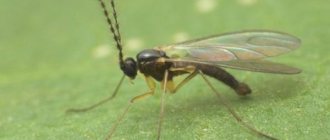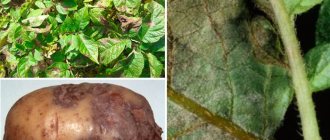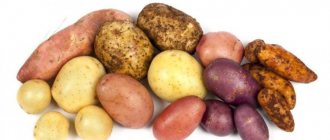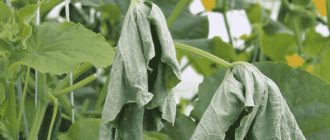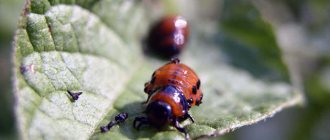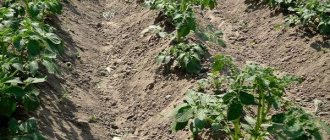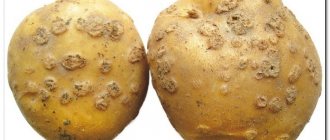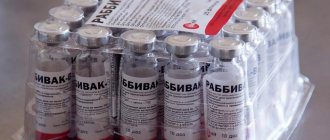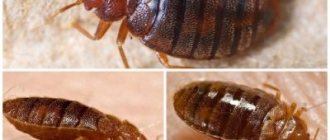Dry rot of potatoes / Dry rot of sunflower / Dry rot of tomatoes /
Alternative title:
fusarium wilt, fusarium blight of potato tubers.
The causative agent of dry rot of potatoes:
fungi Fusarium avenaceum (Fr.) Sacc, Fusarium culmorum (WG Sm.) Sacc, Fusarium gibbosum Appel. et Wollenw, Fusarium oxysporum, Fusarium sambucinum, Fusarium solani.
Dry rot of potato tuber
Dry rot of potatoes is caused by the following types of imperfect fungi: Fusarium avenaceum (Fr.) Sacc, Fusarium culmorum (WG Sm.) Sacc, Fusarium gibbosum Appel. et Wollenw, Fusarium oxysporum, Fusarium sambucinum, Fusarium solani. They affect all parts of the plant: leaves, stems, stolons, tubers.
Dry rot is closely related to Fusarium wilt of potatoes. The disease is widespread and ranks second after late blight.
Causes and source of infection
The causative agents of potato fusarium are fungi of the genus Fusarium; they are found in various types of soil and are activated after the onset of favorable conditions. The disease often especially affects plants grown in soils with a high concentration of nitrogen, well fertilized with manure. Considering this point, in order to exclude cases of fungus appearing on the site, you should not overuse organic fertilizers.
The infection, which is in the ground, begins to penetrate into root crops through mechanical damage. As a result, the disease develops rapidly; the root system of the bush, as well as the stem and leaf apparatus, are affected. During the flowering stage, infected plants experience Fusarium wilt.
Dry rot may not always appear on potato tubers at the initial stage of their development. Even after harvesting and storing it, healthy potatoes may become covered with brown spots. After a few days, these lesions increase in size and disappear. It is extremely difficult to combat rot on tubers; it is better to take preventive measures in a timely manner.
Among the main causes of potato rot are:
- excessive amounts of manure in the ground;
- violations in agricultural technology;
- increased soil moisture against a background of high air temperature;
- presence of mechanical damage on planting material.
When the first signs of dry rot are detected on potatoes, it is necessary to begin the fight against it as quickly as possible. Since the disease spreads very quickly, in a matter of days it can affect other plants growing nearby.
How to fight the disease
When dry rot of potatoes appears on a summer resident’s plot, everyone begins to think about how to deal with it. You first need to understand how widespread the disease is in the area. This can be determined by the tuber. If dry rot is only on the side of the underground lateral shoot, this means that all the soil in the potato bed is contaminated.
If fusarium spots are noticeable on different sides of the tuber, this may indicate improper harvesting or poor storage. Too high a storage temperature (more than 1-3 degrees above zero) contributes to the rapid spread of dry rot.
What contributes to infection?
There are several reasons that accelerate the infection of potatoes with Fusarium dry rot:
- unsorted seed material;
- excess nitrogen in the soil;
- planting with fresh manure:
- damage to tubers by mole crickets or wireworms;
- mechanical damage (cuts, cracks) during harvesting;
- elevated temperature or humidity in the storage room.
Prevention measures
The surest preventative measure for potatoes, as for other root crops, is proper crop rotation. You cannot plant only potatoes in one place for several years in a row. It is best to grow it after zucchini, pumpkin or melons. But after the “second bread” you need to add salads, onions, radishes, radishes, and garlic.
Additional preventive measures against fusarium can be considered:
- sowing green manure after harvesting potatoes;
- selection of high-quality planting material;
- balanced application of fertilizers (without excess nitrogen and with the addition of potassium compounds);
- avoiding mechanical damage to tubers during harvesting;
- proper storage of the harvested crop.
About the fight against this and other potato diseases, watch the video here:
Bacterial diseases of potatoes
Bacterial diseases pose a particular danger to potato plantings. They are virtually impossible to treat; only prevention can save the harvest.
Ring rot
The disease is widespread and develops rapidly, but significant crop losses do not occur. If the disease has become widespread, then agricultural productivity indicators can be 50%.
The disease first affects the stems and tops, and then spreads to root crops. They acquire a watery consistency and become soft. When they are pressed, a yellow liquid appears. The affected area becomes brown in color.
If the infection occurs from the pitted variety of ring rot, then the formation of yellow oil spots occurs under the skin. Methods of combating the disease are reduced to removing the diseased plant at the flowering stage. Affected tubers are removed at harvest.
Brown bacterial rot
Only root vegetables are at risk of infection. The bushes stop growing, and gradual withering of the upper part is observed. Sometimes detecting signs of infection on potatoes in the early stages is quite problematic because... the disease occurs in a latent form. It is not possible to save potatoes from brown rot; only prevention helps protect the future harvest.
Mixed internal rot
When this disease develops, rotting of the entire internal part of the potato is observed. The pathogen penetrates into root crops through wounds, cracks, and other damage. Inside, pathogenic microorganisms cause putrefactive processes, which are detected mainly during winter storage of potatoes.
To preserve harvested potatoes, the room must be cleared of plant residues and treated with copper sulfate.
Wet rot
Wet rot on potatoes can develop under conditions of frequent and abundant irrigation of the soil, when the soil is too dense and the roots experience oxygen starvation. In such an environment, the tubers rot completely. The disease can also progress in damp and cold environments. By external signs, the potatoes look healthy, but when cut, putrefactive manifestations are observed.
Symptoms of the disease
Wet rot at the final stage is difficult to confuse with another disease, since it has extremely pronounced symptoms. The main symptoms of this disease include:
- The internal tissues of the tubers become soft and have an unpleasant odor . At first the rot is white, but over time it darkens and becomes dark brown. The peel may be intact in the initial stages.
- Soft areas may appear on the surface; if you press on them, a light-colored liquid starch mass will be released. In this case, rounded areas of hard tuber tissue will be clearly visible.
- At temperatures close to 0, the skin of the tubers becomes soft and moist, and the eyes die off. Potatoes that have been over-cold cannot be stored because after some time they will begin to rot and thus infect healthy tubers with wet rot.
Control measures
Treating fusarium dry rot on potatoes is ineffective. To prevent the spread of the disease, preventive measures must be taken.
Location on
To avoid the spread of the disease, potato bushes must be periodically inspected. Having discovered diseased specimens, do not hesitate to remove them from the soil. It is recommended to burn affected tubers and tops. It is prohibited to place them in a compost heap.
Proper care of agricultural crops can reduce the likelihood of dry rot on plantings. Plants need to be weeded in a timely manner and the soil under them loosened. Such simple techniques help prevent waterlogging of the soil and thickening of the bushes. It is in a humid environment that the fungus multiplies quickly.
Since the causative agent of a dangerous disease penetrates the tubers through wounds, you should not plant potatoes with mechanical damage (from forks, shovels, pests). Such root vegetables are used either for cooking or as livestock feed.
In the underground
For long-term storage, it is worth selecting only healthy root vegetables, without any damage. They must first be thoroughly dried and kept in the light for one to two weeks, possibly in a barn.
Ways to combat potato rot
The basis for the health of the future harvest is high-quality seeds
- An important condition for obtaining a high-quality harvest is the use of high-quality seeds. It is best to germinate potato tubers before planting in order to immediately identify infected potatoes.
- After rain, it is recommended to loosen the soil to prevent a crust from forming. This will help prevent fungus from causing infection.
- Before planting, potatoes must be treated with a 1.5% boric acid solution (50 ml per 1 kg of tubers).
- If the soil on the site is contaminated, it is better to plant only green manure there for 5–6 years - they will help eliminate the fungus and “pull” it out of the ground.
Carefully study the characteristics of a particular variety before purchasing seeds, and the resistance of the species to various diseases. Treat tubers before planting. Do not store potatoes in a heap in a damp, damp room, even a cellar. Following the simplest rules will help you avoid unpleasant moments and get an excellent harvest.
Prevention measures
When planting potatoes harvested from an area affected by dry rot, a new round of the disease cannot be avoided next year. Among the preventive measures it is worth noting:
- Maintaining crop rotation. It is recommended to plant crops in a place where signs of dry rot were previously found only after five years.
- Soil disinfection. Before planting tubers, it is advisable to sow green manure.
- Treatment of planting material with antibacterial drugs such as Fitosporin, Baktofit. It is also good to treat root vegetables with a solution of copper sulfate, boric acid, and potassium permanganate. In addition to its disinfectant properties, copper contributes to the accelerated process of tuber formation and increased resistance to diseases. Thanks to the use of boron, the taste characteristics of the crop are improved, and the use of manganese allows the accumulation of starch and vitamin C in potatoes.
- In spring, it is recommended to treat the vegetable storage area with disinfectants, ventilate and dry.
- Before storing the tubers for winter storage, they are sprayed with a working solution based on the drug Maxim.
- It is worth planting varieties that are characterized by increased immunity to fungal infections.
- It is not advisable to add large amounts of organic matter containing nitrogen to the soil.
- Regularly loosen the plantings.
We fight dry rot of potatoes
What Russian doesn't like potatoes? My family is no exception. Therefore, on our summer cottage, the lion's share of the land is occupied by potatoes. And no matter how much my friends say, they say, you can buy potatoes in the store, every year we plant 3-4 buckets of this vegetable, beloved by many, because the taste of homemade crumbly potatoes cannot be compared with anything.
However, in recent years, I have increasingly noticed that when cleaning in winter, more and more tubers are black inside. I threw out almost half of the bucket. One day in the spring I told my wise neighbor in the garden about my misfortune, and she said that the potatoes were affected by dry rot - fusarium. Read about how I fought this disease and removed the terrible fungus from the site.
Is it possible to eat affected potatoes?
It is not recommended to eat damaged tubers. You should not feel sorry for such specimens. Even if only one part of the potato is infected, there is no need to cut it off, but rather throw it away completely.
One of the dangerous diseases of potatoes is dry rot; methods of combating it come down solely to carrying out preventive measures. The main thing is to understand why root crops are affected and what factors precede this. Disease-resistant varieties should be selected. Compliance with the rules of crop rotation will minimize the appearance of rot in the garden plot. As soon as signs of illness appear, you need to act immediately.
Conditions of infection
Potatoes can become infected with wet rot in the garden or in storage. This requires special conditions:
- Bacteria that cause wet rot usually enter tubers due to mechanical irritation of the skin by pests and other diseases. Ring rot and blackleg are most often the precursors of wet rot. Potatoes are also often infected as a result of irritation of the tubers by wireworms.
- Wet rot develops best at storage temperatures above 5 degrees Celsius. If the potatoes are poured in large piles and in places where there is high humidity and air temperature, then the disease will spread very quickly throughout the entire potato. In places where there is an outbreak of the disease, the temperature, due to the activity of bacteria, can rise to 50 degrees Celsius. In such places, potatoes quickly rot.
- When tubers are smothered, outbreaks of wet rot often occur. The tubers lack oxygen, and the high carbon dioxide content weakens the immune system. Therefore, in storage, potatoes should not be placed in large piles and reliable ventilation in the room should be ensured. Suffocation can also occur in the soil if the soil is wet and very dense.
- Wet rot develops better in potatoes that have been supercooled at temperatures close to zero. Potatoes that have been stored at temperatures below 0 degrees cannot be stored; they must be isolated and used as soon as possible.
Causes of fusarium wilt of potatoes
First of all, fruits damaged during digging and transportation, as well as those damaged by pests, become sick. Further, this infection spreads to literally all objects and equipment that come into contact with the ground: clothes, shoes, garden tools, damaged root crops, tops, etc.
The peak of disease activity occurs precisely during the period when tubers are set; accordingly, this threatens the landowner with the loss of a significant part of the potato harvest. Tubers affected by fusarium differ from healthy ones by clearly visible depressed spots that are darker in color than the skin - this is rot.
Most often, Fusarium potato blight occurs in the south of Russia, in the Astrakhan and Volgograd regions, in Ukraine and in some regions of the North Caucasus, but the disease may not pass by in other parts of the country.
Main causes of the disease:
- Too high soil moisture caused by prolonged rains and cold, damp weather.
- Planting infected potatoes (all fruits must be carefully checked after wintering).
- Neglecting pre-treatment of the site before planting potatoes.
- A large number of pests, insects and rodents that are carriers of infection.
- Lack of fertilizing, mineral and organic fertilizers in the soil, especially if crops are grown on infertile land.
- Regular planting of potatoes on the same plot of land. All crops require crop rotation.
- Improper storage of potatoes in the cellar.
Hidden and obvious signs of fusarium on potato stems and tubers, description and photo
The plant can be affected by fusarium at any stage of development. The lesion is focal in nature, this is especially noticeable in the midday heat.
Most often, the first symptoms appear during the flowering period: the shade of the leaves changes to lighter, then marginal anthocyanosis begins to develop. Next, the leaves wilt and droop. The color of the lower part of the stem becomes brown; if the air humidity is high, a light coating may appear on its surface, and putrefactive processes begin to develop.
It only takes a few days for the diseased plant to completely wither; dried stems are easily pulled out of the soil. When taking a cross section of the stem, it is easy to see the browning of individual vessels or the entire vascular ring.
The development of fusarium rot on tubers can also occur during storage. A couple of months after laying in the basement, but maybe earlier, dull, grayish-brown spots-dents appear on the surface of the potatoes.
The potato pulp under the spots becomes dry, and voids are formed filled with whitish mycelium of the pathogenic fungus.
The development of pathogen spores on the surface of potatoes appears in the form of yellow, pinkish or white bulges.
Germination of affected potatoes occurs more slowly than healthy ones; the sprouts are thread-like and weak.
The danger lies in the very rapid spread of infection to nearby tubers.
Fusarium, what it looks like, what symptoms can be used to determine the onset of the disease, watch an interesting video:
Preventive procedures
To prevent the disease in order to reduce the risk of infection with fusarium, it is necessary:
- use only healthy planting material;
- choose varieties of planting material only those that can resist fusarium;
- choose planting material that has been treated by the manufacturer against fungal wilt; such seeds have a distinctive color;
- before storing, as well as before planting, treat potato tubers with a fungicide;
- strictly follow the rules of crop rotation;
- mercilessly remove infected plants, together with root soil;
- burn infected plant remains;
- carefully handle garden tools that were used to work with infected plants;
- thoroughly clean shoes from contaminated soil;
- treating with bleach all containers that were used to prepare planting material;
- thoroughly disinfect the soil, especially greenhouse soil;
- Fertilize the planting soil with potassium oxide or lime.
See also
Instructions for use of the drug against the Colorado potato beetle RegentRead
Description of the disease and pathogen
The causative agent of Fusarium disease is the spore fungus Fusarium oxysporum.
Most often, dry rot occurs on cultivated plants in the Far East, as well as in the southern and southeastern regions of Russia.
This fungus and its spores can survive for a long time on the remains of vegetation, in the seed material of affected vegetable crops, as well as in the soil, where it overwinters.
Photo of fusarium potato
Usually, with the onset of warm weather, the fungus becomes active and penetrates plant shoots through the root system and through affected potato tubers.
As a result, the channels through which useful substances move in the shoots become clogged, the plant is left without nutrition and begins to die.
How to get rid of dry rot on potatoes
Fusarium, or dry rot on potatoes, is the most common and dangerous disease. This disease is caused by fungal infections. If their spread is not prevented in time, more than half of the harvest can be lost.
Most gardeners believe that this happens due to improper storage of the crop. But experts say: during storage, only a few percent are allowed to become ill. If we consider the statistics, then most often the infection occurs in young potatoes that are just planted in the soil, and much less often during storage.
The disease is very dangerous due to its easy transmission with soil, and it can also remain on potatoes. As a result, healthy potatoes also become sick.


